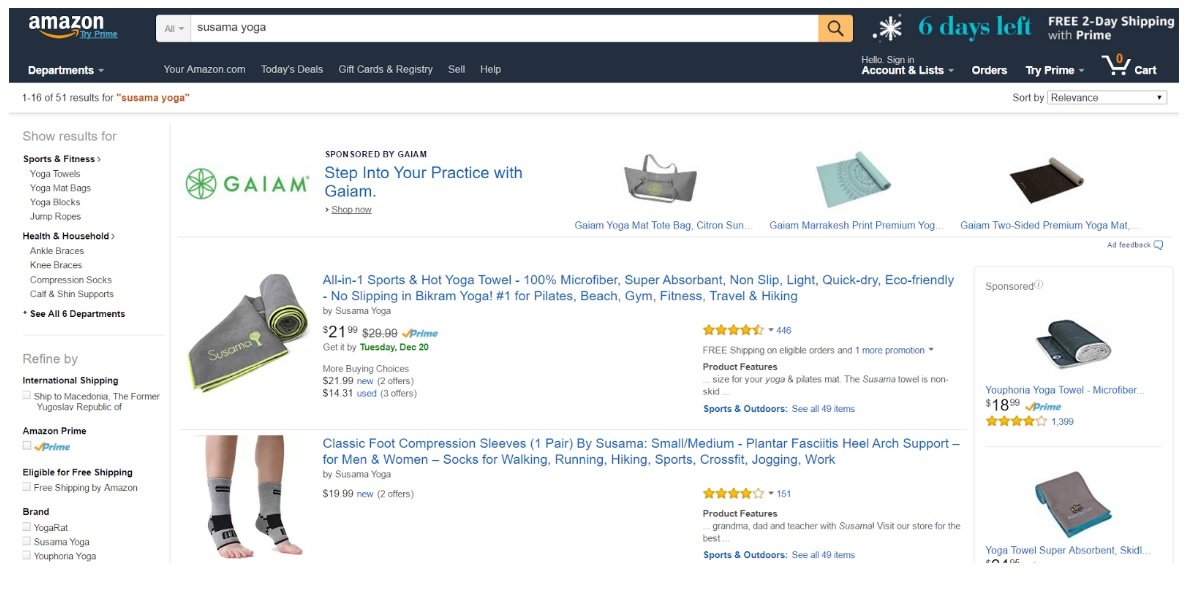
In this week’s article, Stefan Jordev, PPC Manager at Bobsled Marketing, explains the four common situations why ad campaigns are not ranking to their full potential. He dives deep into the most common factors which may be responsible for slow performant ads.
What happens when a shopper searches for your brand on Amazon? One of the several things could happen:
- Your products show up first in the organic search results.
- Your products show up as Sponsored Products ads or Headline Search ads.
- Your products show up organically or as paid placements, but underneath results from your competitors!
Most brand owners want to see their products show up, or, at least, ads for their products, when they search for their brand name on Amazon. Seeing competitors products show up higher in the search results is a disappointing and frustrating outcome, especially if you’ve put a lot of effort into organic listing optimization and PPC.
Many brand owners and marketers are left scratching their heads, wondering what’s missing in this equation.
Unfortunately, the main mission of Amazon’s search engine is not to make vendors and sellers happy. It is to provide buyers with the most relevant products and ultimately help buyers to purchase the product they are interested in, as easily and quickly as possible.
688,000 unique brands sell on Amazon, and they all want to rank first. It’s not hard to see how Amazon’s organic and paid search algorithm might get a little complicated.
ANALYZING sellers’ presence on Amazon
When we analyze sellers’ presence on Amazon, we find four common situations where sellers are most frustrated with their ad campaigns:
- Products do not rank well for brand keywords organically (e.g. “Nike”).
- Products do not rank well for brand keywords in paid search.
- Products do not rank well for main keywords (non-brand) organically.
- Products do not rank well for main keywords in paid search.
Unoptimized PPC Campaigns cost you money. Request a consultation with us as see how we can fix that for you.
{{cta(’84d92f26-f845-47ac-84de-ab77df631479′,’justifycenter’)}}
 Organic vs. Sponsored Results on Amazon.com
Organic vs. Sponsored Results on Amazon.comNow, let’s start dissecting these issues one by one and examine the most common factors which may be costing you sales.
Issue1: Products don’t rank well for brand keywords organically
This is an issue that does warrant true concern. If your product is not showing up for your brand name (and it’s not your first day selling on Amazon, so indexing is not an issue) it is an indicator that your listing is seriously hurt. Let’s say you work for Nike, but when you search for “Nike Air Sneakers,” your products don’t show up in the first few search results—there is something very wrong with that listing. Of course, Amazon SEO is a broad subject. But in an emergency situation like this, you need to immediately check the following:
- Product images (and if there is a “no image” error displayed in the product listing in Seller Central)
- Product title
- Product selling price
- Product description
- Product backend search terms
If everything seems in order here do not hesitate to contact Amazon support ASAP!
Issue 2: Products don’t rank well for brand
keywords in paid search
This is one of the most common questions we get here at Bobsled Marketing. When searching for your brand name and looking at the sponsored product results, keep in mind that ads will only show up for keywords you choose to bid on. Most clients are already running automatic campaigns, so we assume ads will be displayed for your brand name, especially if it is included in your product’s title. But, if you want to guarantee that your ads run for a particular brand name or phrase, create a manual campaign and specifically include it as a keyword.
Protip: You can create a “brand campaign,” including your brand name in and groups with different matching types: brand, phrase, and exact.
Another thing worth mentioning here is that paid search is anyone’s game! More often than not, you will see competitors bidding on your brand name. Even though you have the advantage, because your listing is more relevant to that query, they will often show up and steal some clicks from you!

The best way to defend your listing in these situations is running a “brand campaign,” as I mentioned above. Also, feel free to consider bidding on your competitors’ brand names, but monitor the conversion rate closely. When users search for a brand name they usually have their mind set on buying a particular product, and pushing your product instead can be difficult.
Issue 3: Products do not rank well for main
keyword (non-brand) organically
Amazon sellers usually get discouraged when searching for their main keyword on Amazon, especially if their product is not included in the first results page. In many cases, they shouldn’t! Often, the main keyword is too broad or generic. For example, “men’s sneakers,” “iPhone cases,” and “women’s jeans” are far too broad and stack you up against industry giants with thousands of sales and reviews. It’s almost impossible for your product to rank well for that keyword.
Ask yourself this question: is my main keyword too broad? Hint: if your keyword is a two-word generic phrase, it probably is!
The strategy to consider here is optimizing for long-tail keywords rather than generic ones.
Long-tail keywords are usually four or five word phrases that you can optimize your listing for using your products unique features. Granted, these have much lower search volume, but they are usually keywords that convert better and you can rank higher relatively easy for them. Example: Red Nike running shoes for men
Protip: Identify up to 10 long tail keywords and start optimizing your listing for them (title, description, backend keywords.
Need expert help with your Amazon PPC campaigns? Contact us to request a consultation, or learn more about our PPC philosophy.
Issue 4: Products do not rank well for main
keywords in paid search
Unlike organic search results, in paid search you have more maneuvering space and levers to pull. Just remember to optimize your product listings for organic search before spending money in paid search. This includes optimizing product titles, descriptions, images, and back-end search terms.
Including the keyword everywhere in your listing will improve your product’s relevancy. The other piece of the puzzle is the bid for that keyword and its matching type.
Protip: The best practice to follow here is to create three ad groups for broad, phrase, and exact keyword matches. Be sure to include the main keyword in all three with different bids, broad being the lowest bid and exact being the highest. Example:
Mens sneakers (broad) – $1.5
Mens sneakers (phrase) – $2.0
Men sneakers (exact) – $2.5
This strategy ensures you are bidding higher for keywords that are more likely to convert (exact keywords), and still get your ads displayed on searches for keywords you may still not be aware of. Remember, even the best keyword research tool can’t predict your target audience’s searching patterns.
Bottom Line
With so over 400 million SKUs and almost 700,000 brands being sold on Amazon today, competition is intense both for organic and paid search ranking. Having a basic understanding of what drives Amazon’s search algorithm helps brands to maximize their effort and ROI.
Amazon does keep their exact search algorithm under close guard. But the good news is that it is certainly possible for brands to ensure their products display prominently when customers search for their brand name. If you’re facing this issue, do an audit of your product listings and campaigns using the steps above, and you’ll likely uncover the reason why your ads aren’t displaying.


